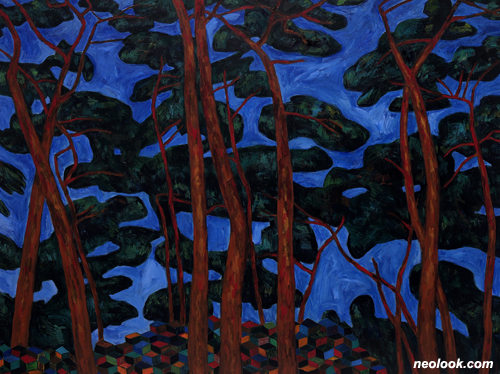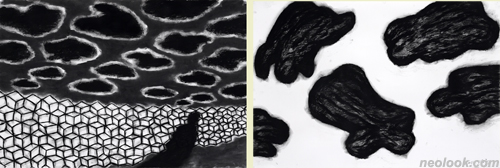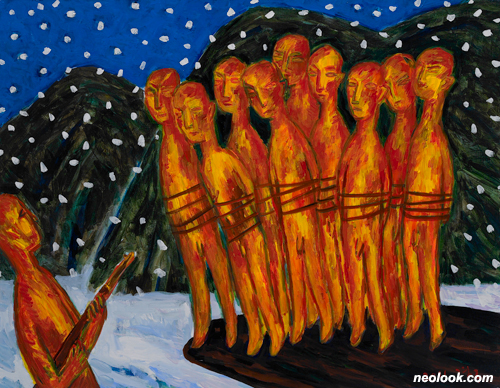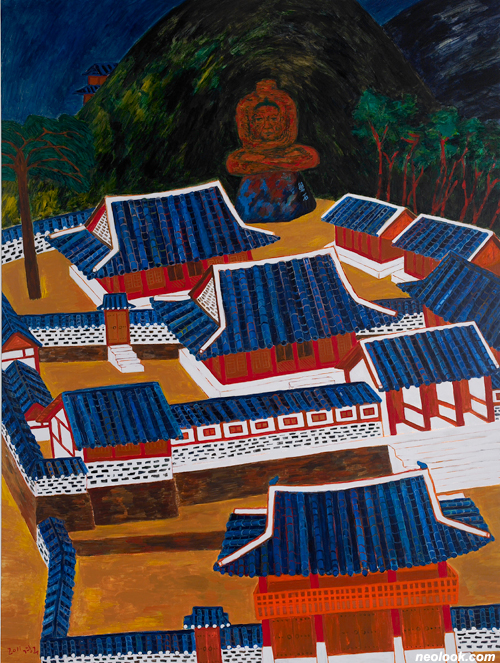- ● homepage
- ● archives
- ● restoration
- ● books
- ● big banners
- ● post board
- ■ neo's search
- ■ about us
- ■ 게재방법 안내
- 개인정보처리방침

- [email protected]
- Tel. 02_335_7922
- Fax. 02_335_7929
- 10:00am~04:30pm
- 월요일~금요일
- 3/3(월) 대체공휴일

먼 그림자 - 산성일기
강경구展 / KANGKYUNGKOO / 姜敬求 / painting 2011_0615 ▶ 2011_0715 / 월요일 휴관
● 위 이미지를 클릭하면 네오룩 아카이브 Vol.20100504f | 강경구展으로 갑니다.
초대일시 / 2011_0615_수요일_05:00pm
기획 / 사비나미술관 학예연구실
관람료 / 성인 2,000원 / 학생 1,000원
관람시간 / 10:00am~06:30pm / 월요일 휴관
사비나미술관 Savina Museum of Contemporary Art 서울 종로구 안국동 159번지 Tel. +82.2.736.4371 www.savinamuseum.com
뿌리내린 미학, 그리고 기억과 장소로 돌아가기 ● 1. 시간의 흔적 저장하기 강경구의 회화는 공연한 멋을 부리지 않는다. 붓 터치에서는 기교나 잔꾀가 최대한 배제된다. 색은 장식이나 시각효과를 위해 실현되지 않는다. 과도한 감각주의나 형식적 패턴화도 이 세계와 큰 연관이 없다. 세련미란 본시 태초의 정서, 살아있음, 함축이나 정제의 대상이 되기를 거부하는 꿈틀거림과는 거리가 먼 것이다. 세련미의 토대는 태동이 아니라 종결이며, 그 안에서 생명은 형식이 되고 느낌은 언어로 종착한다. 대단원, 곧 종말로부터의 묵시록적 신호인 셈이다. 진정한 내적 재능을 소유한 영혼이라면, 이 신호의 수신자로 전락하지 않는 길을 직관적으로 알고 있을 터이다. 이러한 지식에는 반드시 덧없는 세련미의 거부라는 항목이 포함되어 있다. 접근은 각기 다르더라도, 꿈틀거림, 자주 시각적 어설픔의 양태를 하는 풋풋함을 향한 지속적인 반전(反轉)이 목격되기 마련이다. 강경구의 붓 끝에서 결행되고 있는 싸움의 의미 역시 여기서 멀지 않다. ● 강경구가 그린 소나무들만 봐도 그렇다. 그것들은 고고한 기상(氣像)과 멋진 자태를 뽐내지 않는다. 거칠고 분방하고 소박한 터치들은 애초부터 일련의 형식주의적 완성을 욕망하지 않는다. 터치들이 남긴 불규칙하고 생생한 흔적은 요인들이 세련미로 재구성되는 정제의 과정을 허용하지 않는다. 이 소나무들은 산성의 담벼락과 계곡과 하늘이 그렇듯, 세련된 회화의 조건들, 모더니즘적 형식주의와 스타일의 도그마를 위한 조형적 고려들을 받아들일 의향이 전혀 없다.

- 강경구_붉은나무 3_캔버스에 아크릴채색_193.9×259.1cm_2011
조형형식에 대한 작가의 변함없는 태도 하나는 짚고 넘어가자. 안료들의 생경한 뒤엉킴, 터치들 간의 변증적 긴장감 같은 것은 그가 캔버스에 아크릴 안료를 사용하는 한국화가 이기에 가능해진 미덕이다. 하지만, 그에게 그것은 전위스러운 도발도 아니며, 전통과 현대를 뒤섞는다는 식의 거창한 실험과도 무관하다. 강경구에게 '지필묵'은 뿌리며 근원이지만, 넘나들 수 없는 규범은 아니며 현재를 옭아매는 강령은 더더욱 아니다. 중요한 것은 추상화되는 대신 구체적이 되는 것이고, 그 구체성 안에서 최대한 자유를 선택하는 것이다. 질료나 조형어법이 규범이 되어야 할 이유가 어디에 있겠는가. 켜켜한 안료의 층을 통해 시간의 흔적을 저장해 두는 것이 중요하다면, 그래서 아크릴의 덧칠이 요구된다면, 전통적인 발묵의 고상함을 한 수 뒤로 물린다 해서 문제될 것은 없다.

- 강경구_현절사_캔버스에 아크릴채색_80.3×116.8cm_2011
작가에게 안료는 단순한 채색의 도구적 기제 이상이다. 그에게 안료는 눈에 보이는 현재의 재현이 아니라 타임머신이고 공간이동이다. 그 층들 사이에 과거로부터 현재에 이르는 수 세기의 시간이 함축되어 있다. 아마도 그 어딘가가 역사의 길목이며 기억의 출입구일 것이다. 터치들은 그 여행, 상상의 감도를 조절한다.

- 강경구_먼 그림자_켄트지에 목탄_76×112cm_2011 강경구_원형질_켄트지에 목탄_76×112cm_2011
2. 장소성, 미학의 뿌리내리기 ● 강경구의 세계에서 소나무는 역사를 매개하고, 기억을 불러오는 시간적 기제다. 그것들의 붉은 가지와 푸른 잎파리들은 아마도 17세기의 어느 해에도 대동소이했을 것이다. 당시에도 오늘처럼 골짜기마다 소나무가 우거져 있고, 그 위로 눈이 쌓였을 것이다. 바람이 불면 뾰족한 솔잎들 사이사이에서 '휘이'하는 숨소리가 들려오곤 했을 것이고, 야밤의 대기는 동일한 푸른 색조를 띠었을 것이다. 작가는 2011년의 남한산성에서 무릎을 꿇은 조선의 국왕과 그 앞에 거만하게 팔장을 낀 채 걸터앉았던 적장을 만난다. 그들의 모습은 적송(赤松)들 사이로 모습을 드러냈다가는 이내 울창한 침엽수림 사이로 사라져버린다. 어떤 기억들은 가지 끝에 자신들의 온전치 못한 형상들을 걸어놓는다. 작가는 녹색의 잎들을 뭉쳐진 울혈처럼 다룸으로써, 역사를 살다간 일원들, 부상자들, 억울한 영혼들의 통시적 메타포로 작용하도록 한다.

- 강경구_병자년 2_캔버스에 아크릴채색_91×116.8cm_2011

- 강경구_떠도는 이야기_캔버스에 아크릴채색_91×116.8cm_2011
이 회화에서 사물은 형태적 측면이 아니라 서사적 차원으로 기운다. 회화공간은 역사적 담지체가 되고, 이미지는 다시 해석적 기제라는 예년의 특권을 회복한다. 일테면 작가는 소나무를 재현하는 것이 아니라, 바람이 불 때마다 소리를 내며 되돌아오는 기억의 일환들을 재구성하는 것이다. 즉 작가는 풍경을 그리는 것이 아니라 기억을 다루고 있는 것이며, 풍광을 음미하는 것이 아니라 장소를 경험하고 있는 것이다, 붓질은 병자년의 기억을 되살리고 삼학사의 역사를 불러내는 행위가 된다. 시간은 기억을 통해 주체화되고, 공간은 장소가 됨으로써 역사에 개입하는 것이다. 즉 지금으로부터 375년 전(1636,인조 14) 12월 남한산성은 우리의 기억이 되었고 장소가 되었다. 청(淸)의 태종(太宗)이 10만 대군을 이끌고 침입해 남한산성(南漢山城)을 포위했을 그 때 조선의 국론은 양분되어 있었다. 신하들은 주전파(主戰派)와 주화파(主和派)로 나뉘어졌다. 격한 갑론을박이 산성을 메웠고, 수근거림과 음모(陰謀)가 뒤를 이었다. 김상헌(金尙憲)을 중심으로 한 주전파는 결사항전을 주장했고, 최명길(崔鳴吉)을 위시한 주화파는 화친을 주장했다. 역사는 주화파가 우세를 점하도록 허락했고, 인조는 산성에서 나와 항복을 고해야만 했다. 그러는 동안 수많은 조선인들이 눈발이 날리는 어느 날 산성 근처의 이름없는 골짜기들에서 싸우다 죽거나 처형되어야 했다. 그들 중 홍익한(洪翼漢)·윤집(尹集)·오달제(吳達濟)는 척화(斥和)의 주모자로 몰려 중국으로 끌려갔다. 하지만 모진 고문과 회유, 심지어 참형(斬刑)까지도 그 삼학사(三學士)의 뜻을 굽게 할 수는 없었다. 이들 삼학사의 지조와 잘린 세 개의 머리가 강경구의 이번 전시를 밝히는 화두처럼 언급된다. 작품 「현절사,顯節祠」에서 보듯, 작가에게 남한산성은 이들의 지조와 충절, 망향의 애달픔과 억울한 참형의 기억과 불가불리(不可不離)다. ● 강경구의 회화는 그의 인식의 지향이 뿌리로 향하고 있음을 밝힌다. 흔히들 착각해 왔던 것처럼 예술은 '무한의 지평선과 코스모폴리탄적 보편주의', '비역사적인 가정(假定)과 직선적인 진보'를 향해 곧장 나아가는 것과는 거리가 멀다. 진정한 예술은 오히려 자신과의 만남을 주선할 뿐이다. 오락이나 선동이 그토록 배제하고자 하는 가치인 자기자신과의 대면(對面) 말이다. 그리고 자신을 만나는 노선에는 필히 과거와 기억의 경유가 포함된다. ● 그러므로 병인년의 남한산성으로 난 길, 역사를 보듬는 그 침엽수림 안으로 접어들자는 것은 특별히 진보의 흥분에 들떠 있으며, 모두가 앞으로 달음박질해 나가는 것 외의 관심은 거두어들인, 오늘날과 같은 불모의 시대에 있어선 참으로 신선한 기획이 아닐 수 없다. 이야말로 '직접적인 삶의 환경 속에서 미(美)의 출처를 발굴해내려는 시도요, 정주(定住) 속에서 진실을 추구하는" 태도이기 때문이다. 강경구의 회화적 지평은 우리에게 '자신의 삶의 터전에서 잘려져 나오지 않기'와 '역사와 결별함으로써 뿌리가 뽑혀나간 예술 넘어서기'의 한 가능성을 제안한다. 오늘날 만연해 있는 우리의 '터전을 상실한 미적 풍토'에 경종을 울리면서 말이다. ■ 심상용

- 강경구_겨울_캔버스에 아크릴채색_130.3×162.2cm_2011
Radicated Aesthetics and a Return to Memory and Place ● Preserving the Trace of Time Kang Gyunggu's painting is not pretentious., He excludes all kinds of technical tricks in his brush strokes. His colors are decorative but they don't necessarily constitute visual effects. Indeed, his art has nothing to do with excessive sensationalism and patterns. As a matter of fact, refinement is far from aliveness or the beginning. In other words, refinement is based not on completion, but on initiation. And in that, life becomes formality and feelings turn into grammar. It is an apocalyptic signal from the finale. Anyone who has true intrinsic values would understands how not to fall into the position of the receiver of such signal, and would reject unnecessary refinement. And how to approach to such understanding might be various, nevertheless we often witness a consistent rejection of refinement under the disguise of amateurish visual aspects. In this sense, Kang's struggle represented in his brush stroke is not much different. ● For instance, in his pine trees we don't find any condescending attitude, and they never show off through their graceful form. His simple and ingenuous brush strokes don't seek to accomplish such a completion of formalism. The irregular and vivid traces of his strokes don't even allow a process of refinement to reconstruct and polish them. As well as the mountain fortress, valley and sky in his paintings, these pine trees don't seem to have any formal resemblances to the elements in refined stylistically dogmatic or modernistically formal paintings. ● And here we should discuss the artist's consistent attitude regarding his formative styles. The unfamiliar mixture of pigments and the tension seen in the brushstrokes were made possible because of his background as a Korean painting artist who works mainly on canvas with acrylic paints. Nevertheless, to him it is not a radical provocation to use those materials. Further it has nothing to do with an experiment to muddle up tradition with modernity. 'Ji.Pil.Mook(Paper, Brush, Chinese Ink)' is no more than the foundation of his art: it never restricts his art. The important thing here is that instead of making abstract, his images become more concrete and free within the realm of concreteness. Why do we limit ourselves to the standards of formativeness or certain materials? If preserving the trace of time by painting layers of pigments is very important in the realization of his theme, and for that reason if painting over acrylic colors is required, there should not be any problem retreating from the practice of the refinement of the Balmuk(blurring Chinese ink) technique. ● To this artist, pigments are more than a coloring material. They are materials that not only represent the present, but act as a time machine and a tool to express a movement of space. Between the layers of pigment, many centuries are implied. Maybe somewhere in the layers there is a historical corner or an exit of memory, and the brush strokes control the sensitivity of such imagination. ● Sense of Place: The Establishment of Aesthetics In Kang's art world, pine trees are the medium of history and the time mechanism that evokes memory. The red pine tree branches and green pine needles would have been not so much different from that of a period in the 17th century. Probably around that time all the valleys were also filled with pine trees and on top of the trees there would have been some snow. When wind blew, the sharp pine needles would have made a whistling sound that resembled a breathing sound, and the night air would have had the same bluish atmosphere like that of these days. In 2011, the artist encounters an enemy commander arrogantly sitting in front of the kneeling King of Chosun at the Southern Palace (Namhan Sansung). Their images appear through the red pine trees and then disappear. Some branches have abnormal shapes. By expressing the green pine needles as agglomerated blood congestions, they become diachronic metaphors of the victimized souls of the past. ● In this painting, the objects have more to do with the aspect of narrative than the aspect of shape. The space in his painting becomes a container of history, and the images recover the former privilege as an analytical mechanism. For instance, the artist's representation of pine trees here reconstructs memories returned by the whistling sound of the pine trees. In other words, the artist is not just drawing a landscape, but is dealing with lost memories. He is not just appreciating the view, but rather he is experimenting with the place. His brush stroke revives the memory of the Byungjahoran (the Manchu war of 1636), and recalls the history of the three scholars captured by the Manchu. Time becomes the central body through which memory and space become place; it thereby intervenes in history. Through his paintings, the memory of December, 1636 at the South Palace becomes our memory and place. ● When Taizong of the Qing Dynasty besieged the South Palace with an army of a hundred thousand soldiers, public opinion in Chosun was polarized. The courtiers were divided into Jujeonpa and Juhwapa, and intense debates were prevalent throughout the mountain fortress as rumors and conspiracy thrived. With Kim Sangheon as the central figure, the Jujeonpa insisted on resistance, while Choi Myunggil of the Juhwapa insisted on amity. In the end, the Juhwapa won out over Jujeonpa, and King Injo had to come out of the mountain fortress and surrender. In the mean time, a lot of Chosun people died through both battle and execution. Amongst them, Hong Ikhwan, Yoon Jib, Oh Dalje were captured and brought to Qing as the leaders of "the rejection of peace". However, harsh tortures, placation or even a cruel punishment could not make them change their minds. The fidelity of these three men and their heads are the implied theme of Kang Gyunggu's exhibition this time. As seen in Hyunjeolsa, to the artist, The South Palace is inseparable from these scholars' fidelity, the sorrows of their homesickness and the memory of the unfair punishment. ● Kang's painting elucidates that his consciousness is focused on fundamentals. As is often misunderstood by many people, art is far from going straight toward 'infinite horizon and cosmopolitan universalism' or 'non-historical supposition and straightforward progress.' Rather real art is more about an encounter with the self, which is what entertainment attempts to exclude. And in the process of facing the self, the artist must traverse memory memory. ● Therefore, the way toward the South Palace of 1636, the invitation to the pine tree forest is a fresh project for today's barren age where people are only interested in the rush toward progress. This indeed is an attempt to excavate beauty's roots in reality, and is an attitude of the pursuit of truth. The artistic prospects of the artist suggest how not to be disconnected from one's livelihood and how to overcome the art that got separated from history, by raising alarm toward the situation whereby in today's rampant atmosphere aesthetics that has lost its base. ■ Shim Sangyong
Vol.20110615h | 강경구展 / KANGKYUNGKOO / 姜敬求 / painting

